Principles of Nursing Management for Asthma Patients Essay
VerifiedAdded on 2022/11/25
|9
|2574
|344
Essay
AI Summary
This essay delves into the respiratory system, focusing on asthma as a chronic condition. It explores asthma's health issues, pathophysiology, including airway inflammation, and various clinical and molecular phenotypes. The essay reviews major concepts such as childhood and adult-onset asthma, occupational asthma, and severe asthma, providing a comprehensive understanding of the disease. A nursing management plan is developed, covering nursing diagnoses, goals, expected outcomes, and interventions, including airway management, breathing pattern support, and activity intolerance management. The essay also discusses the importance of evaluation in the nursing process. Finally, it examines how nurses can advance their roles in the workplace by improving inhaler techniques, avoiding triggers, and developing personalized asthma action plans, highlighting the value of literature review in enhancing nursing practice and improving patient outcomes.
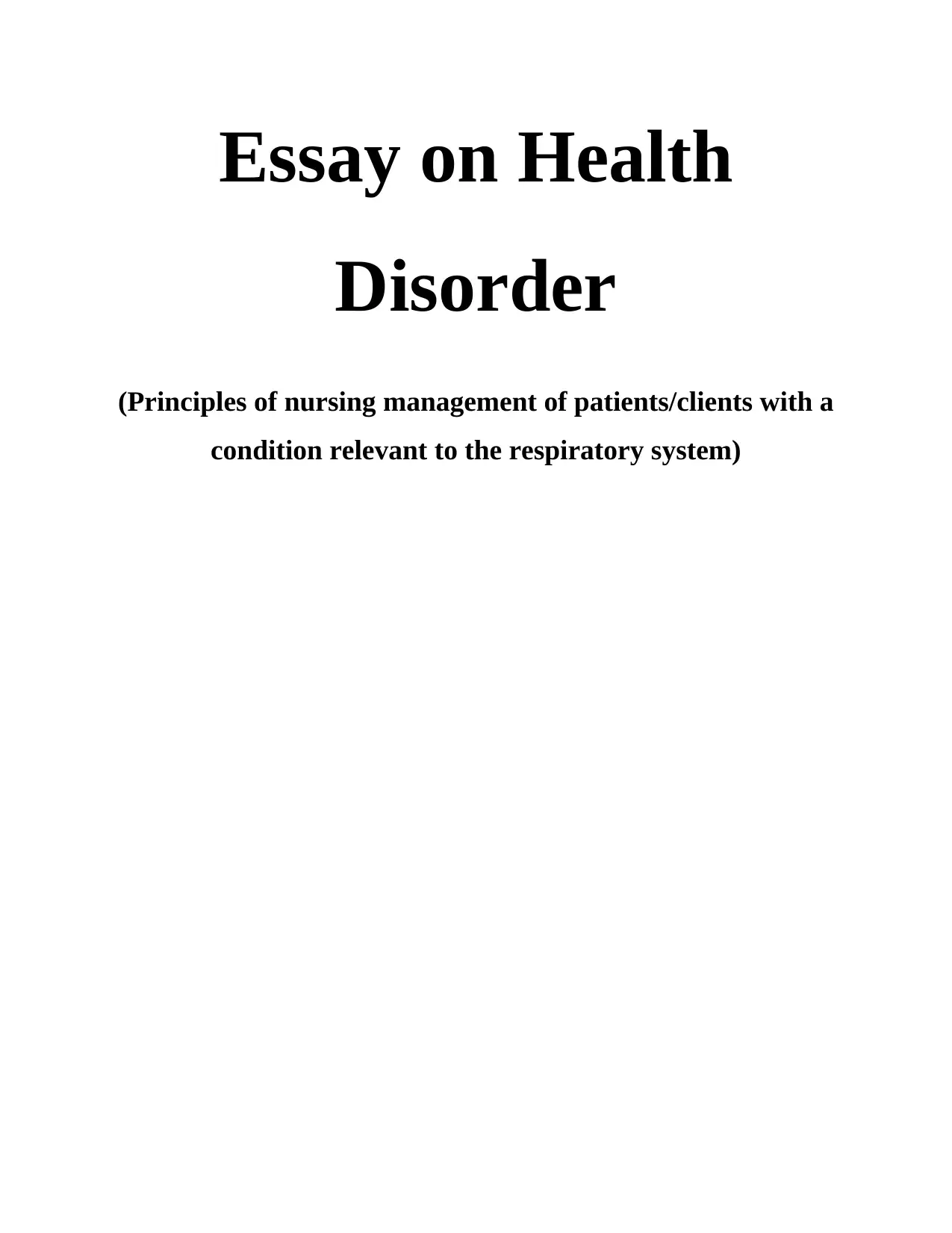
Essay on Health
Disorder
(Principles of nursing management of patients/clients with a
condition relevant to the respiratory system)
Disorder
(Principles of nursing management of patients/clients with a
condition relevant to the respiratory system)
Paraphrase This Document
Need a fresh take? Get an instant paraphrase of this document with our AI Paraphraser
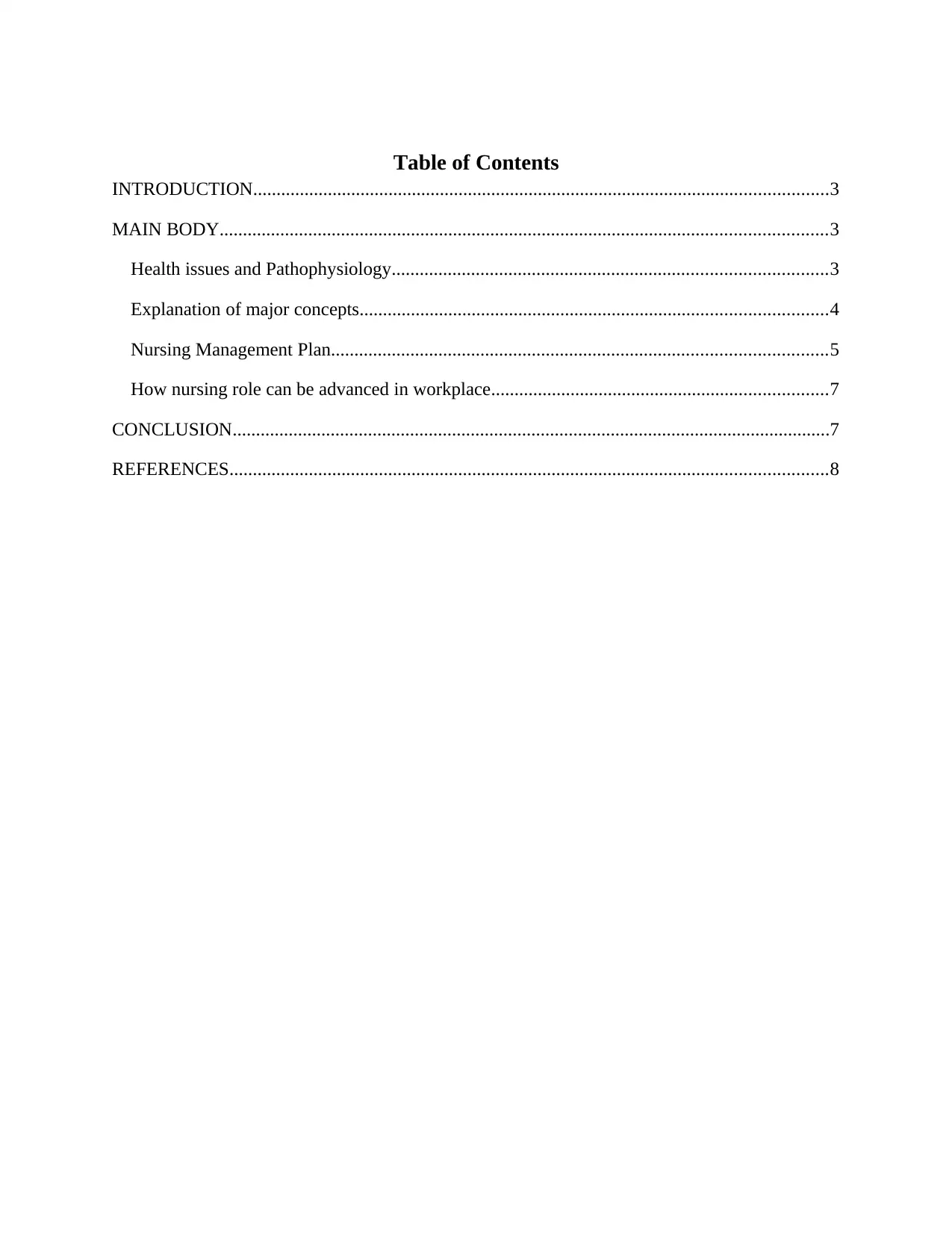
Table of Contents
INTRODUCTION...........................................................................................................................3
MAIN BODY..................................................................................................................................3
Health issues and Pathophysiology.............................................................................................3
Explanation of major concepts....................................................................................................4
Nursing Management Plan..........................................................................................................5
How nursing role can be advanced in workplace........................................................................7
CONCLUSION................................................................................................................................7
REFERENCES................................................................................................................................8
INTRODUCTION...........................................................................................................................3
MAIN BODY..................................................................................................................................3
Health issues and Pathophysiology.............................................................................................3
Explanation of major concepts....................................................................................................4
Nursing Management Plan..........................................................................................................5
How nursing role can be advanced in workplace........................................................................7
CONCLUSION................................................................................................................................7
REFERENCES................................................................................................................................8
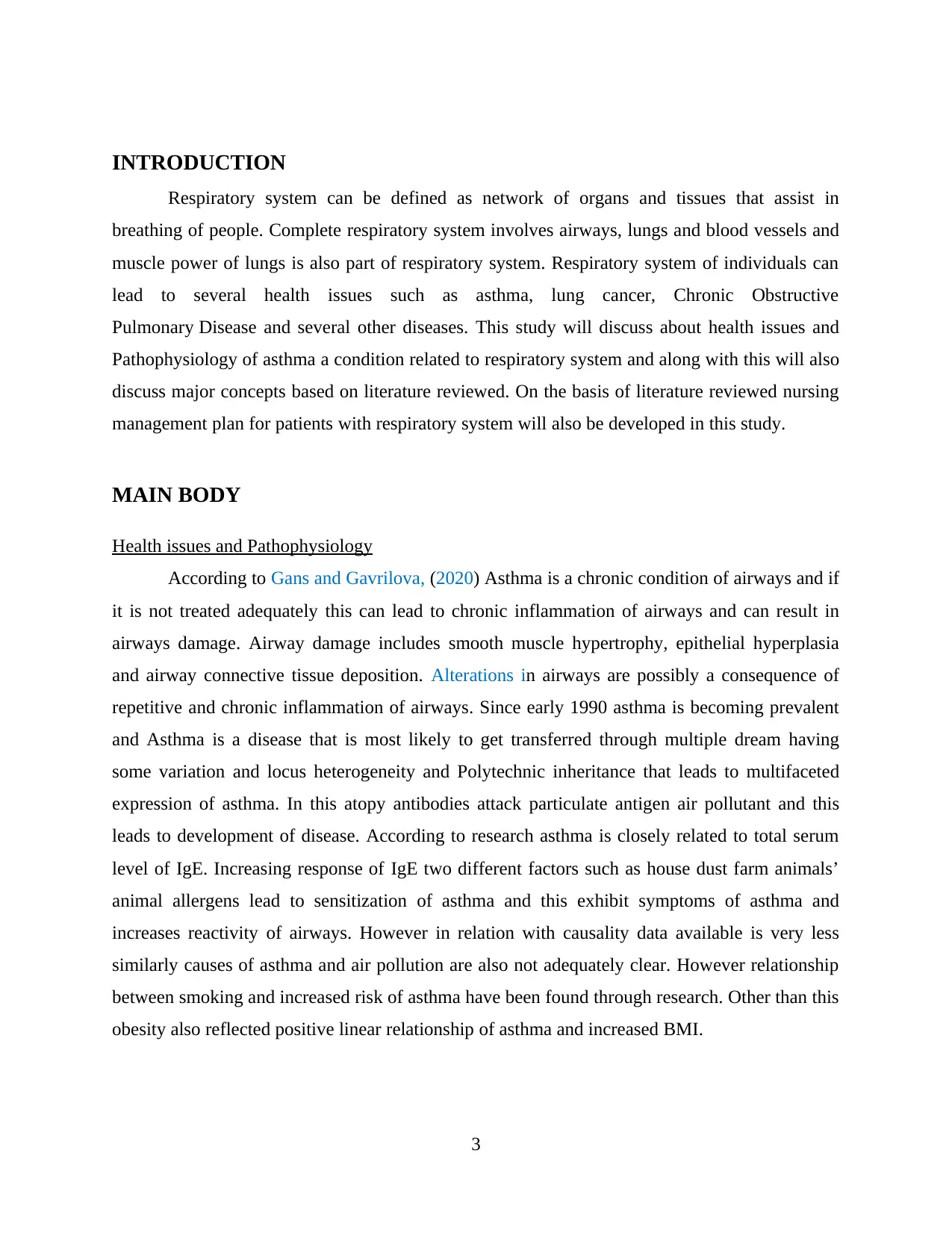
INTRODUCTION
Respiratory system can be defined as network of organs and tissues that assist in
breathing of people. Complete respiratory system involves airways, lungs and blood vessels and
muscle power of lungs is also part of respiratory system. Respiratory system of individuals can
lead to several health issues such as asthma, lung cancer, Chronic Obstructive
Pulmonary Disease and several other diseases. This study will discuss about health issues and
Pathophysiology of asthma a condition related to respiratory system and along with this will also
discuss major concepts based on literature reviewed. On the basis of literature reviewed nursing
management plan for patients with respiratory system will also be developed in this study.
MAIN BODY
Health issues and Pathophysiology
According to Gans and Gavrilova, (2020) Asthma is a chronic condition of airways and if
it is not treated adequately this can lead to chronic inflammation of airways and can result in
airways damage. Airway damage includes smooth muscle hypertrophy, epithelial hyperplasia
and airway connective tissue deposition. Alterations in airways are possibly a consequence of
repetitive and chronic inflammation of airways. Since early 1990 asthma is becoming prevalent
and Asthma is a disease that is most likely to get transferred through multiple dream having
some variation and locus heterogeneity and Polytechnic inheritance that leads to multifaceted
expression of asthma. In this atopy antibodies attack particulate antigen air pollutant and this
leads to development of disease. According to research asthma is closely related to total serum
level of IgE. Increasing response of IgE two different factors such as house dust farm animals’
animal allergens lead to sensitization of asthma and this exhibit symptoms of asthma and
increases reactivity of airways. However in relation with causality data available is very less
similarly causes of asthma and air pollution are also not adequately clear. However relationship
between smoking and increased risk of asthma have been found through research. Other than this
obesity also reflected positive linear relationship of asthma and increased BMI.
3
Respiratory system can be defined as network of organs and tissues that assist in
breathing of people. Complete respiratory system involves airways, lungs and blood vessels and
muscle power of lungs is also part of respiratory system. Respiratory system of individuals can
lead to several health issues such as asthma, lung cancer, Chronic Obstructive
Pulmonary Disease and several other diseases. This study will discuss about health issues and
Pathophysiology of asthma a condition related to respiratory system and along with this will also
discuss major concepts based on literature reviewed. On the basis of literature reviewed nursing
management plan for patients with respiratory system will also be developed in this study.
MAIN BODY
Health issues and Pathophysiology
According to Gans and Gavrilova, (2020) Asthma is a chronic condition of airways and if
it is not treated adequately this can lead to chronic inflammation of airways and can result in
airways damage. Airway damage includes smooth muscle hypertrophy, epithelial hyperplasia
and airway connective tissue deposition. Alterations in airways are possibly a consequence of
repetitive and chronic inflammation of airways. Since early 1990 asthma is becoming prevalent
and Asthma is a disease that is most likely to get transferred through multiple dream having
some variation and locus heterogeneity and Polytechnic inheritance that leads to multifaceted
expression of asthma. In this atopy antibodies attack particulate antigen air pollutant and this
leads to development of disease. According to research asthma is closely related to total serum
level of IgE. Increasing response of IgE two different factors such as house dust farm animals’
animal allergens lead to sensitization of asthma and this exhibit symptoms of asthma and
increases reactivity of airways. However in relation with causality data available is very less
similarly causes of asthma and air pollution are also not adequately clear. However relationship
between smoking and increased risk of asthma have been found through research. Other than this
obesity also reflected positive linear relationship of asthma and increased BMI.
3
⊘ This is a preview!⊘
Do you want full access?
Subscribe today to unlock all pages.

Trusted by 1+ million students worldwide

As per Vasileiadis and et.al., (2019) organ system that gets affected by asthma is lungs.
Lungs consist of lobes and segment in which right lung have 10 segments and left lung have 8 or
9 segment which depends on division of line. Respiratory system has two zones and these zones
are marked by conducting zone and respiratory zone. Asthma is primarilyinvolved in tree in
which its primary job is to disseminate air to lungs until it reaches alveolar sacs. Patients with
asthma experience physiological mechanism changes caused by inflammation and decreasing
radius of airways. All this mechanism together changes compliance of lungs to increase work of
breathing. In simple word because of physiological event that leads two clinical symptoms is
narrowing Airways and subsequently with interfere with air flow. Acute asthma consist of
bronchial smooth muscle contraction that quickly narrow airways in retaliation to subjection of
various stimuli such as allergens and irritants. BOULET, (2017) states that as asthma become
persistent and inflation more progressive in such situation other factors lead to limiting air flow.
Risk factors include edema, inflammation mucus hypersecretion and creation of inspissated
mucus plugs. In pathophysiology of asthma inflammation have Central role and definition of
asthma also outlines airways inflammation because of introduction of different types of cells and
multiple mediators with airways leading to consequences of characteristic pathophysiological
features of asthma. Pathophysiological characteristics of asthma include bronchial inflammation
and airflow limitation and these causes’ repetitive episodes of cough, wheeze and shortness of
breath.
Explanation of major concepts
Tung and et.al., (2018) outlines that there are different concepts of asthma and this
concept include-
Clinical and inflammatory phenotyping- In 1940 Rackemann described to clinical asthmatic
phenotypes. Extrinsic was considered to be posed by allergens because of exposure outside the
body and other allergic diseases and also because of younger age of emergence of disease.
Intrinsic asthma is considered to be caused by factors that are intrinsic to body and were existing
regardless of season and environment and also lacked atopy. In addition to this intrinsic asthma
also is caused by older age of onset.
Molecular physiologic phenotyping- Molecular or physiological phenotyping involves the use
of molecular disease pathways for identifying groups of patients who respond to certain
4
Lungs consist of lobes and segment in which right lung have 10 segments and left lung have 8 or
9 segment which depends on division of line. Respiratory system has two zones and these zones
are marked by conducting zone and respiratory zone. Asthma is primarilyinvolved in tree in
which its primary job is to disseminate air to lungs until it reaches alveolar sacs. Patients with
asthma experience physiological mechanism changes caused by inflammation and decreasing
radius of airways. All this mechanism together changes compliance of lungs to increase work of
breathing. In simple word because of physiological event that leads two clinical symptoms is
narrowing Airways and subsequently with interfere with air flow. Acute asthma consist of
bronchial smooth muscle contraction that quickly narrow airways in retaliation to subjection of
various stimuli such as allergens and irritants. BOULET, (2017) states that as asthma become
persistent and inflation more progressive in such situation other factors lead to limiting air flow.
Risk factors include edema, inflammation mucus hypersecretion and creation of inspissated
mucus plugs. In pathophysiology of asthma inflammation have Central role and definition of
asthma also outlines airways inflammation because of introduction of different types of cells and
multiple mediators with airways leading to consequences of characteristic pathophysiological
features of asthma. Pathophysiological characteristics of asthma include bronchial inflammation
and airflow limitation and these causes’ repetitive episodes of cough, wheeze and shortness of
breath.
Explanation of major concepts
Tung and et.al., (2018) outlines that there are different concepts of asthma and this
concept include-
Clinical and inflammatory phenotyping- In 1940 Rackemann described to clinical asthmatic
phenotypes. Extrinsic was considered to be posed by allergens because of exposure outside the
body and other allergic diseases and also because of younger age of emergence of disease.
Intrinsic asthma is considered to be caused by factors that are intrinsic to body and were existing
regardless of season and environment and also lacked atopy. In addition to this intrinsic asthma
also is caused by older age of onset.
Molecular physiologic phenotyping- Molecular or physiological phenotyping involves the use
of molecular disease pathways for identifying groups of patients who respond to certain
4
Paraphrase This Document
Need a fresh take? Get an instant paraphrase of this document with our AI Paraphraser
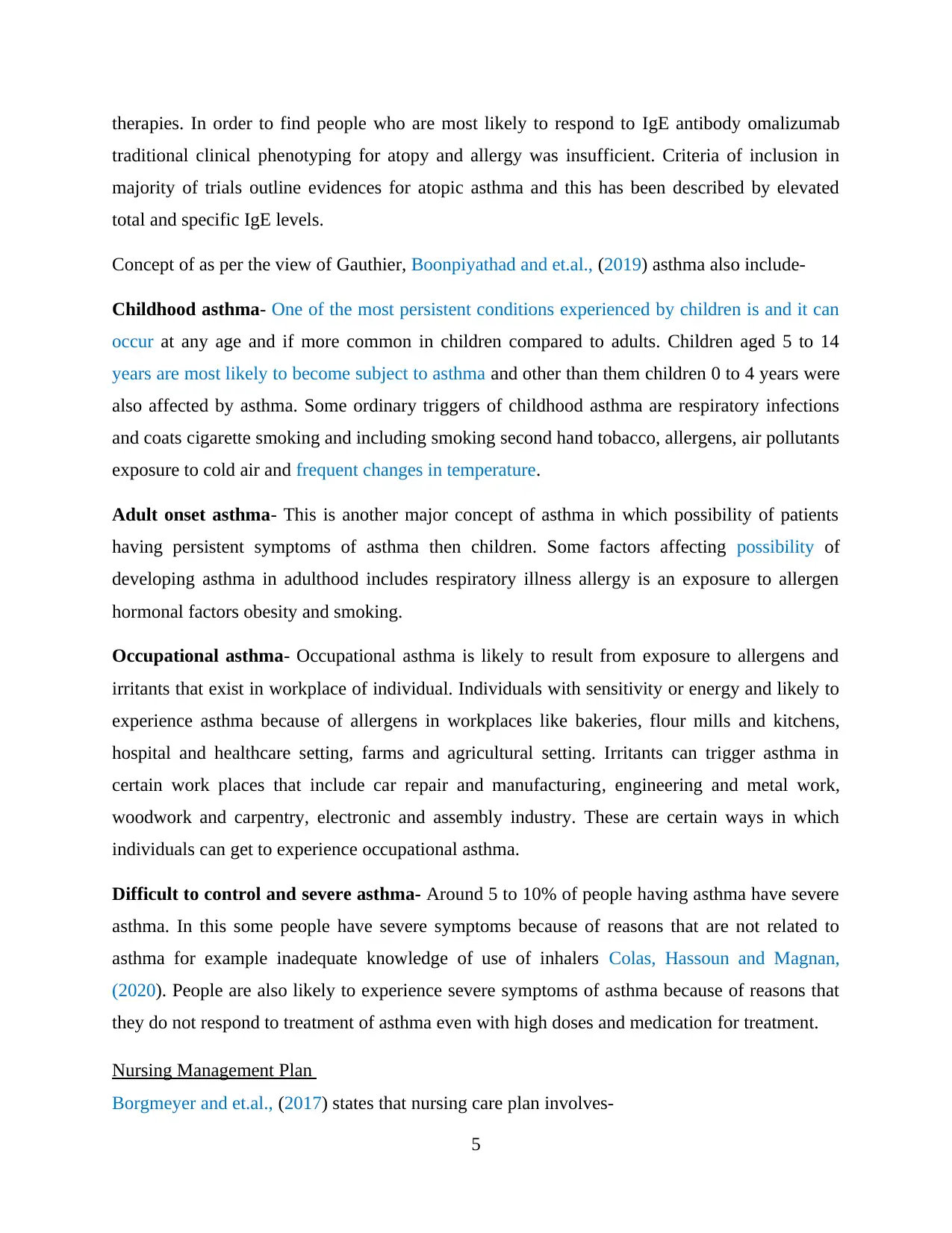
therapies. In order to find people who are most likely to respond to IgE antibody omalizumab
traditional clinical phenotyping for atopy and allergy was insufficient. Criteria of inclusion in
majority of trials outline evidences for atopic asthma and this has been described by elevated
total and specific IgE levels.
Concept of as per the view of Gauthier, Boonpiyathad and et.al., (2019) asthma also include-
Childhood asthma- One of the most persistent conditions experienced by children is and it can
occur at any age and if more common in children compared to adults. Children aged 5 to 14
years are most likely to become subject to asthma and other than them children 0 to 4 years were
also affected by asthma. Some ordinary triggers of childhood asthma are respiratory infections
and coats cigarette smoking and including smoking second hand tobacco, allergens, air pollutants
exposure to cold air and frequent changes in temperature.
Adult onset asthma- This is another major concept of asthma in which possibility of patients
having persistent symptoms of asthma then children. Some factors affecting possibility of
developing asthma in adulthood includes respiratory illness allergy is an exposure to allergen
hormonal factors obesity and smoking.
Occupational asthma- Occupational asthma is likely to result from exposure to allergens and
irritants that exist in workplace of individual. Individuals with sensitivity or energy and likely to
experience asthma because of allergens in workplaces like bakeries, flour mills and kitchens,
hospital and healthcare setting, farms and agricultural setting. Irritants can trigger asthma in
certain work places that include car repair and manufacturing, engineering and metal work,
woodwork and carpentry, electronic and assembly industry. These are certain ways in which
individuals can get to experience occupational asthma.
Difficult to control and severe asthma- Around 5 to 10% of people having asthma have severe
asthma. In this some people have severe symptoms because of reasons that are not related to
asthma for example inadequate knowledge of use of inhalers Colas, Hassoun and Magnan,
(2020). People are also likely to experience severe symptoms of asthma because of reasons that
they do not respond to treatment of asthma even with high doses and medication for treatment.
Nursing Management Plan
Borgmeyer and et.al., (2017) states that nursing care plan involves-
5
traditional clinical phenotyping for atopy and allergy was insufficient. Criteria of inclusion in
majority of trials outline evidences for atopic asthma and this has been described by elevated
total and specific IgE levels.
Concept of as per the view of Gauthier, Boonpiyathad and et.al., (2019) asthma also include-
Childhood asthma- One of the most persistent conditions experienced by children is and it can
occur at any age and if more common in children compared to adults. Children aged 5 to 14
years are most likely to become subject to asthma and other than them children 0 to 4 years were
also affected by asthma. Some ordinary triggers of childhood asthma are respiratory infections
and coats cigarette smoking and including smoking second hand tobacco, allergens, air pollutants
exposure to cold air and frequent changes in temperature.
Adult onset asthma- This is another major concept of asthma in which possibility of patients
having persistent symptoms of asthma then children. Some factors affecting possibility of
developing asthma in adulthood includes respiratory illness allergy is an exposure to allergen
hormonal factors obesity and smoking.
Occupational asthma- Occupational asthma is likely to result from exposure to allergens and
irritants that exist in workplace of individual. Individuals with sensitivity or energy and likely to
experience asthma because of allergens in workplaces like bakeries, flour mills and kitchens,
hospital and healthcare setting, farms and agricultural setting. Irritants can trigger asthma in
certain work places that include car repair and manufacturing, engineering and metal work,
woodwork and carpentry, electronic and assembly industry. These are certain ways in which
individuals can get to experience occupational asthma.
Difficult to control and severe asthma- Around 5 to 10% of people having asthma have severe
asthma. In this some people have severe symptoms because of reasons that are not related to
asthma for example inadequate knowledge of use of inhalers Colas, Hassoun and Magnan,
(2020). People are also likely to experience severe symptoms of asthma because of reasons that
they do not respond to treatment of asthma even with high doses and medication for treatment.
Nursing Management Plan
Borgmeyer and et.al., (2017) states that nursing care plan involves-
5
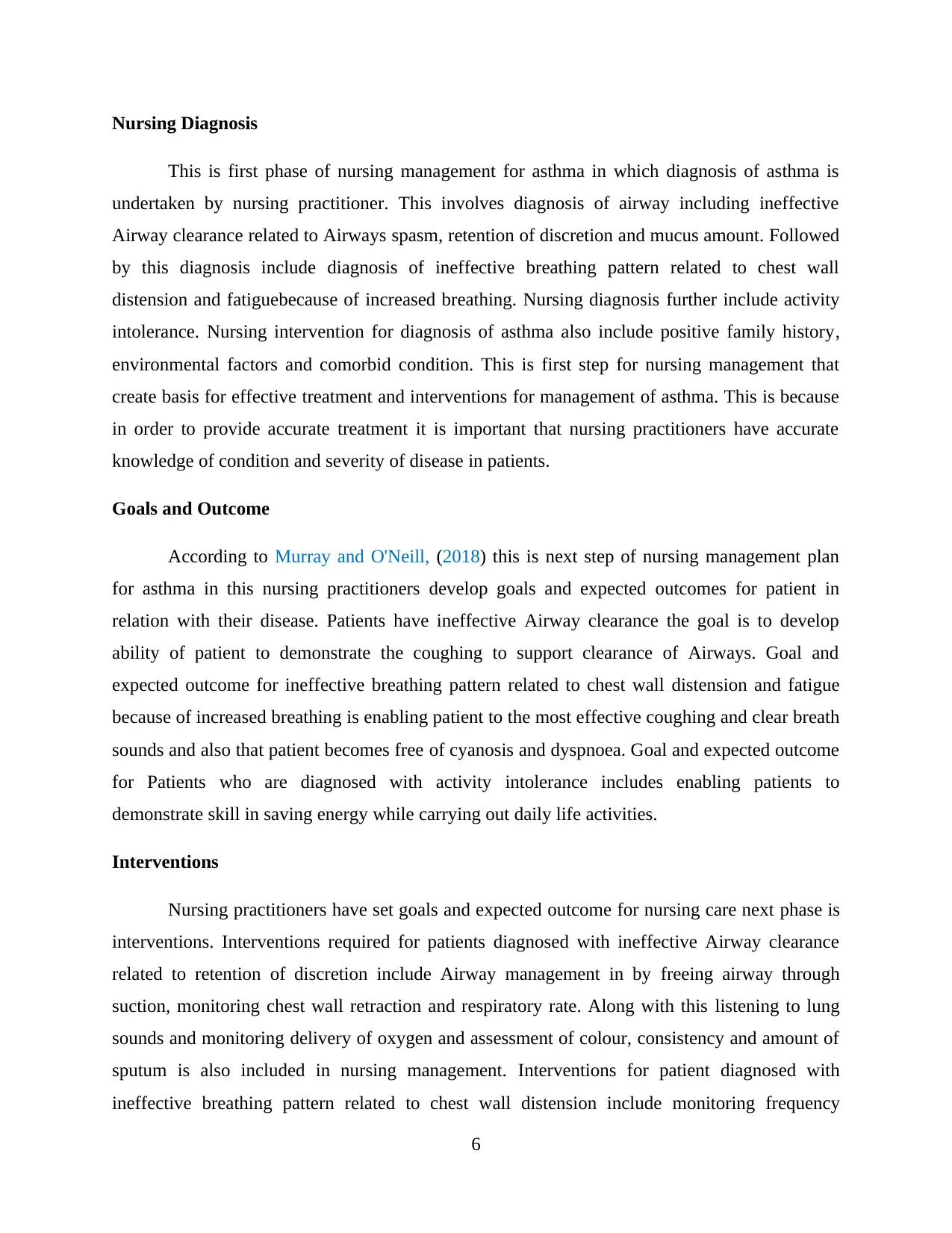
Nursing Diagnosis
This is first phase of nursing management for asthma in which diagnosis of asthma is
undertaken by nursing practitioner. This involves diagnosis of airway including ineffective
Airway clearance related to Airways spasm, retention of discretion and mucus amount. Followed
by this diagnosis include diagnosis of ineffective breathing pattern related to chest wall
distension and fatiguebecause of increased breathing. Nursing diagnosis further include activity
intolerance. Nursing intervention for diagnosis of asthma also include positive family history,
environmental factors and comorbid condition. This is first step for nursing management that
create basis for effective treatment and interventions for management of asthma. This is because
in order to provide accurate treatment it is important that nursing practitioners have accurate
knowledge of condition and severity of disease in patients.
Goals and Outcome
According to Murray and O'Neill, (2018) this is next step of nursing management plan
for asthma in this nursing practitioners develop goals and expected outcomes for patient in
relation with their disease. Patients have ineffective Airway clearance the goal is to develop
ability of patient to demonstrate the coughing to support clearance of Airways. Goal and
expected outcome for ineffective breathing pattern related to chest wall distension and fatigue
because of increased breathing is enabling patient to the most effective coughing and clear breath
sounds and also that patient becomes free of cyanosis and dyspnoea. Goal and expected outcome
for Patients who are diagnosed with activity intolerance includes enabling patients to
demonstrate skill in saving energy while carrying out daily life activities.
Interventions
Nursing practitioners have set goals and expected outcome for nursing care next phase is
interventions. Interventions required for patients diagnosed with ineffective Airway clearance
related to retention of discretion include Airway management in by freeing airway through
suction, monitoring chest wall retraction and respiratory rate. Along with this listening to lung
sounds and monitoring delivery of oxygen and assessment of colour, consistency and amount of
sputum is also included in nursing management. Interventions for patient diagnosed with
ineffective breathing pattern related to chest wall distension include monitoring frequency
6
This is first phase of nursing management for asthma in which diagnosis of asthma is
undertaken by nursing practitioner. This involves diagnosis of airway including ineffective
Airway clearance related to Airways spasm, retention of discretion and mucus amount. Followed
by this diagnosis include diagnosis of ineffective breathing pattern related to chest wall
distension and fatiguebecause of increased breathing. Nursing diagnosis further include activity
intolerance. Nursing intervention for diagnosis of asthma also include positive family history,
environmental factors and comorbid condition. This is first step for nursing management that
create basis for effective treatment and interventions for management of asthma. This is because
in order to provide accurate treatment it is important that nursing practitioners have accurate
knowledge of condition and severity of disease in patients.
Goals and Outcome
According to Murray and O'Neill, (2018) this is next step of nursing management plan
for asthma in this nursing practitioners develop goals and expected outcomes for patient in
relation with their disease. Patients have ineffective Airway clearance the goal is to develop
ability of patient to demonstrate the coughing to support clearance of Airways. Goal and
expected outcome for ineffective breathing pattern related to chest wall distension and fatigue
because of increased breathing is enabling patient to the most effective coughing and clear breath
sounds and also that patient becomes free of cyanosis and dyspnoea. Goal and expected outcome
for Patients who are diagnosed with activity intolerance includes enabling patients to
demonstrate skill in saving energy while carrying out daily life activities.
Interventions
Nursing practitioners have set goals and expected outcome for nursing care next phase is
interventions. Interventions required for patients diagnosed with ineffective Airway clearance
related to retention of discretion include Airway management in by freeing airway through
suction, monitoring chest wall retraction and respiratory rate. Along with this listening to lung
sounds and monitoring delivery of oxygen and assessment of colour, consistency and amount of
sputum is also included in nursing management. Interventions for patient diagnosed with
ineffective breathing pattern related to chest wall distension include monitoring frequency
6
⊘ This is a preview!⊘
Do you want full access?
Subscribe today to unlock all pages.

Trusted by 1+ million students worldwide
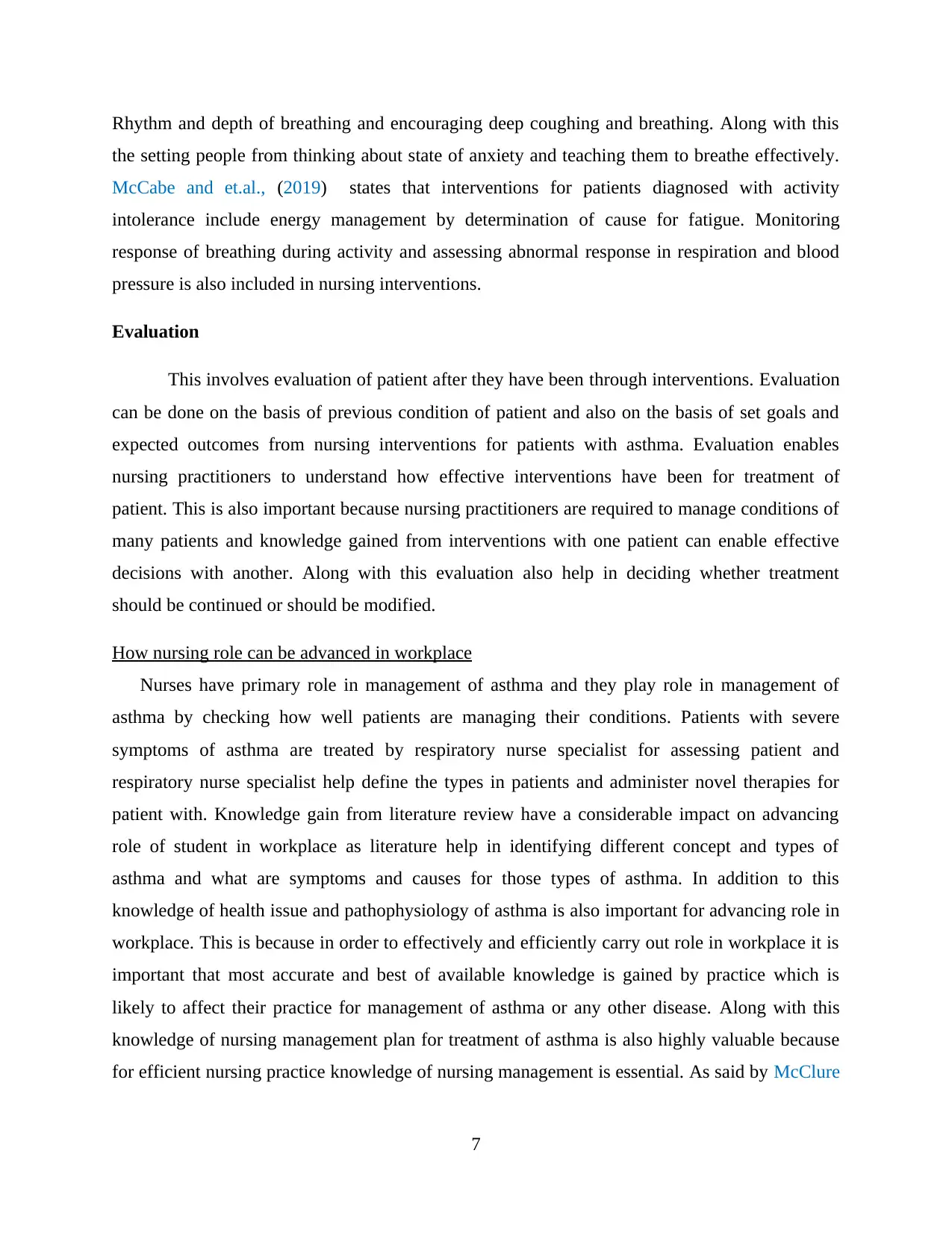
Rhythm and depth of breathing and encouraging deep coughing and breathing. Along with this
the setting people from thinking about state of anxiety and teaching them to breathe effectively.
McCabe and et.al., (2019) states that interventions for patients diagnosed with activity
intolerance include energy management by determination of cause for fatigue. Monitoring
response of breathing during activity and assessing abnormal response in respiration and blood
pressure is also included in nursing interventions.
Evaluation
This involves evaluation of patient after they have been through interventions. Evaluation
can be done on the basis of previous condition of patient and also on the basis of set goals and
expected outcomes from nursing interventions for patients with asthma. Evaluation enables
nursing practitioners to understand how effective interventions have been for treatment of
patient. This is also important because nursing practitioners are required to manage conditions of
many patients and knowledge gained from interventions with one patient can enable effective
decisions with another. Along with this evaluation also help in deciding whether treatment
should be continued or should be modified.
How nursing role can be advanced in workplace
Nurses have primary role in management of asthma and they play role in management of
asthma by checking how well patients are managing their conditions. Patients with severe
symptoms of asthma are treated by respiratory nurse specialist for assessing patient and
respiratory nurse specialist help define the types in patients and administer novel therapies for
patient with. Knowledge gain from literature review have a considerable impact on advancing
role of student in workplace as literature help in identifying different concept and types of
asthma and what are symptoms and causes for those types of asthma. In addition to this
knowledge of health issue and pathophysiology of asthma is also important for advancing role in
workplace. This is because in order to effectively and efficiently carry out role in workplace it is
important that most accurate and best of available knowledge is gained by practice which is
likely to affect their practice for management of asthma or any other disease. Along with this
knowledge of nursing management plan for treatment of asthma is also highly valuable because
for efficient nursing practice knowledge of nursing management is essential. As said by McClure
7
the setting people from thinking about state of anxiety and teaching them to breathe effectively.
McCabe and et.al., (2019) states that interventions for patients diagnosed with activity
intolerance include energy management by determination of cause for fatigue. Monitoring
response of breathing during activity and assessing abnormal response in respiration and blood
pressure is also included in nursing interventions.
Evaluation
This involves evaluation of patient after they have been through interventions. Evaluation
can be done on the basis of previous condition of patient and also on the basis of set goals and
expected outcomes from nursing interventions for patients with asthma. Evaluation enables
nursing practitioners to understand how effective interventions have been for treatment of
patient. This is also important because nursing practitioners are required to manage conditions of
many patients and knowledge gained from interventions with one patient can enable effective
decisions with another. Along with this evaluation also help in deciding whether treatment
should be continued or should be modified.
How nursing role can be advanced in workplace
Nurses have primary role in management of asthma and they play role in management of
asthma by checking how well patients are managing their conditions. Patients with severe
symptoms of asthma are treated by respiratory nurse specialist for assessing patient and
respiratory nurse specialist help define the types in patients and administer novel therapies for
patient with. Knowledge gain from literature review have a considerable impact on advancing
role of student in workplace as literature help in identifying different concept and types of
asthma and what are symptoms and causes for those types of asthma. In addition to this
knowledge of health issue and pathophysiology of asthma is also important for advancing role in
workplace. This is because in order to effectively and efficiently carry out role in workplace it is
important that most accurate and best of available knowledge is gained by practice which is
likely to affect their practice for management of asthma or any other disease. Along with this
knowledge of nursing management plan for treatment of asthma is also highly valuable because
for efficient nursing practice knowledge of nursing management is essential. As said by McClure
7
Paraphrase This Document
Need a fresh take? Get an instant paraphrase of this document with our AI Paraphraser

and et.al., (2017) certain ways in which literature review and knowledge gained from literature
review can assist in advancing role in workplace include
Helping patients with their inhaler techniques- this involves that patients are helped with
techniques for inhaler so that they are able to manage asthma through appropriateinhaler
technique
Helping patients in avoiding triggers of asthma and providing them support and advice
for avoiding triggers of asthma such as cessation of smoking. Triggers of asthma are both
factors that can lead to worsening of asthma condition in an patient and for management
of asthma it is important that such triggers are avoided by patients
Increasing frequency of reviews- in this patient and practitioner need to increase
frequency of reviews for better management of asthma
Working in partnership with patient for developing personalized asthma Action Plan that
address is requirement of individual patient for treatment of asthma
Stepping up medication- this involves determining medication required for patients
according to their asthma condition so that it can be managed adequately.
CONCLUSION
It can be summarised that literature review has enabled to gain important and required
information for management of asthma. Health issues and pathophysiology helps in identifying
basic features and characteristics of asthma. This is very important knowledge for diagnosis and
management of asthma by nursing practitioner. Pathophysiology of asthma also involves
identifying causes and effect along with physical functioning of body during asthma. Concept of
asthma help in identifying different types and concept associated with disease to understand
different types and impact of disease on individuals.
8
review can assist in advancing role in workplace include
Helping patients with their inhaler techniques- this involves that patients are helped with
techniques for inhaler so that they are able to manage asthma through appropriateinhaler
technique
Helping patients in avoiding triggers of asthma and providing them support and advice
for avoiding triggers of asthma such as cessation of smoking. Triggers of asthma are both
factors that can lead to worsening of asthma condition in an patient and for management
of asthma it is important that such triggers are avoided by patients
Increasing frequency of reviews- in this patient and practitioner need to increase
frequency of reviews for better management of asthma
Working in partnership with patient for developing personalized asthma Action Plan that
address is requirement of individual patient for treatment of asthma
Stepping up medication- this involves determining medication required for patients
according to their asthma condition so that it can be managed adequately.
CONCLUSION
It can be summarised that literature review has enabled to gain important and required
information for management of asthma. Health issues and pathophysiology helps in identifying
basic features and characteristics of asthma. This is very important knowledge for diagnosis and
management of asthma by nursing practitioner. Pathophysiology of asthma also involves
identifying causes and effect along with physical functioning of body during asthma. Concept of
asthma help in identifying different types and concept associated with disease to understand
different types and impact of disease on individuals.
8

REFERENCES
Books and Journals
Boonpiyathad, T and et.al., 2019, December. Immunologic mechanisms in asthma. In Seminars
in immunology (Vol. 46, p. 101333). Academic Press.
Borgmeyer, A and et.al., 2017. Pediatric nurse practitioners effective in teaching providers the
Asthma Action Plan using simulation. Journal of pediatric nursing. 34. pp.53-57.
BOULET, L.P., 2017. Pathophysiology of asthma. Applied Respiratory Pathophysiology, p.67.
Colas, L., Hassoun, D. and Magnan, A., 2020. Needs for systems approaches to better treat
individuals with severe asthma: predicting phenotypes and responses to
treatments. Frontiers in medicine. 7. p.98.
Gans, M.D. and Gavrilova, T., 2020. Understanding the immunology of asthma:
pathophysiology, biomarkers, and treatments for asthma endotypes. Paediatric
respiratory reviews, 36, pp.118-127.
McCabe, E.M and et.al., 2019. A review of school nurses’ self-efficacy in asthma care. The
Journal of School Nursing, 35(1), pp.15-26.
McClure, N and et.al., 2017. Enhancing pediatric asthma care and nursing education through an
academic practice partnership. Journal of pediatric nursing. 36. pp.64-69.
Murray, B. and O'Neill, M., 2018. Supporting self-management of asthma through patient
education. British Journal of Nursing. 27(7). pp.396-401.
Tung, H.Y and et.al., 2018, February. Advances and evolving concepts in allergic asthma.
In Seminars in respiratory and critical care medicine (Vol. 39, No. 01, pp. 064-081).
Thieme Medical Publishers.
Vasileiadis, I and et.al., 2019. Acid-base disturbances in patients with asthma: a literature review
and comments on their pathophysiology. Journal of clinical medicine, 8(4), p.563.
9
Books and Journals
Boonpiyathad, T and et.al., 2019, December. Immunologic mechanisms in asthma. In Seminars
in immunology (Vol. 46, p. 101333). Academic Press.
Borgmeyer, A and et.al., 2017. Pediatric nurse practitioners effective in teaching providers the
Asthma Action Plan using simulation. Journal of pediatric nursing. 34. pp.53-57.
BOULET, L.P., 2017. Pathophysiology of asthma. Applied Respiratory Pathophysiology, p.67.
Colas, L., Hassoun, D. and Magnan, A., 2020. Needs for systems approaches to better treat
individuals with severe asthma: predicting phenotypes and responses to
treatments. Frontiers in medicine. 7. p.98.
Gans, M.D. and Gavrilova, T., 2020. Understanding the immunology of asthma:
pathophysiology, biomarkers, and treatments for asthma endotypes. Paediatric
respiratory reviews, 36, pp.118-127.
McCabe, E.M and et.al., 2019. A review of school nurses’ self-efficacy in asthma care. The
Journal of School Nursing, 35(1), pp.15-26.
McClure, N and et.al., 2017. Enhancing pediatric asthma care and nursing education through an
academic practice partnership. Journal of pediatric nursing. 36. pp.64-69.
Murray, B. and O'Neill, M., 2018. Supporting self-management of asthma through patient
education. British Journal of Nursing. 27(7). pp.396-401.
Tung, H.Y and et.al., 2018, February. Advances and evolving concepts in allergic asthma.
In Seminars in respiratory and critical care medicine (Vol. 39, No. 01, pp. 064-081).
Thieme Medical Publishers.
Vasileiadis, I and et.al., 2019. Acid-base disturbances in patients with asthma: a literature review
and comments on their pathophysiology. Journal of clinical medicine, 8(4), p.563.
9
⊘ This is a preview!⊘
Do you want full access?
Subscribe today to unlock all pages.

Trusted by 1+ million students worldwide
1 out of 9
Related Documents
Your All-in-One AI-Powered Toolkit for Academic Success.
+13062052269
info@desklib.com
Available 24*7 on WhatsApp / Email
![[object Object]](/_next/static/media/star-bottom.7253800d.svg)
Unlock your academic potential
Copyright © 2020–2025 A2Z Services. All Rights Reserved. Developed and managed by ZUCOL.





